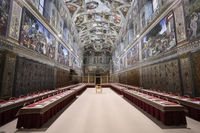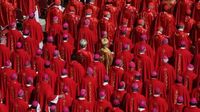The eyes of the world are on Vatican City as the conclave begins to elect a successor to Pope Francis. The event is steeped in tradition and secrecy, with 133 cardinals from 71 countries gathering to choose the 267th pope.
On May 7, 2025, the conclave officially commenced, starting with a solemn mass in St. Peter's Basilica, led by 91-year-old Cardinal Giovanni Battista Re, who also officiated Pope Francis' funeral just weeks prior. This mass is not just a ceremonial beginning; it sets a reflective tone for the cardinal electors as they prepare for the significant responsibility ahead of them.
After the mass, the cardinals moved to the Cappella Paolina in the Apostolic Palace for a prayer service, invoking the Holy Spirit's guidance by singing "Veni Creator Spiritus". Following this, they entered the Sistine Chapel, where the atmosphere shifted to one of solemnity and commitment. Each cardinal took an oath of secrecy regarding the election process, ensuring that the deliberations would remain confidential.
At 4:30 PM, Cardinal Raniero Cantalamessa, who at 90 years old is no longer eligible to vote, delivered a meditation to the cardinals. This moment is crucial as it prepares the electors spiritually for the weighty decision they are about to undertake. After his reflection, the doors to the chapel were ceremonially closed, marking the official start of the conclave.
The first round of voting was anticipated to occur later that evening, with smoke signals expected around 7 PM. White smoke would indicate the election of a new pope, while black smoke would signify that no decision had been reached, prompting further rounds of voting. Historically, the last two conclaves in 2005 and 2013 concluded within two days, suggesting that a new pope could emerge swiftly.
As the cardinals cast their votes, they will do so four times a day—twice in the morning and twice in the afternoon—until a candidate receives the required two-thirds majority, which in this case translates to 89 votes or more. The cardinals are housed at Casa Santa Marta, a guesthouse designed to keep them isolated from outside influences, allowing them to focus solely on their task.
The secrecy surrounding the conclave is paramount. Not only do the cardinals pledge confidentiality, but all staff involved, including drivers and Swiss Guards, are also bound by oaths to maintain discretion. This practice is intended to prevent any external influence, whether from governments or powerful individuals, on the sacred process of electing a new pope.
In the days leading up to the conclave, cardinals engaged in the novemdiales, a nine-day period of mourning for Pope Francis. Daily masses were held in St. Peter's Basilica for his soul, and various discussions took place among the cardinals regarding the future direction of the Church.
Speculation about potential candidates for the papacy has been rife. While previous elections had clear frontrunners, this time the field appears more open, with no single figure standing out as a clear favorite. The shifting demographics of the Catholic Church, particularly the growing influence of African and Asian cardinals, could play a significant role in the decision-making process. As noted by Vatican correspondent Andrea Vreede, the Catholic faith is expanding rapidly in these regions, with one in five Catholics now hailing from Africa.
As the conclave unfolds, the world watches closely. The Vatican's newspaper, Osservatore Romano, will publish a special edition announcing the new pope, who will be revealed from the balcony of St. Peter's Basilica. The cardinal protodeacon will announce the new leader with the words, "Annuntio vobis gaudium magnum, habemus papam," which translates to, "I announce to you a great joy, we have a pope." This moment is one of the most anticipated in the Catholic Church, symbolizing continuity and hope for millions of believers worldwide.
In summary, the conclave of 2025 marks a pivotal moment for the Catholic Church as it seeks a new leader to guide its faithful in an increasingly complex world. With the cardinals convened in the historic Sistine Chapel, the process of selecting a successor to Pope Francis has begun, shrouded in mystery and solemnity, yet filled with hope for the future of the Church.


